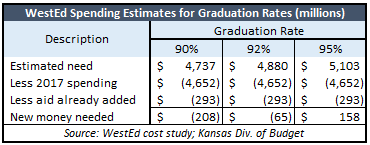Revised estimates from the authors of the WestEd cost study show current school funding is adequate to produce up to a 92 percent high school graduation rate. That’s not to validate the notion that funding can be calculated to produce any particular outcome, mind you, but judges and others who buy into the theory and are now enamored with the cost study should acknowledge this inconvenient truth.
The study initially showed maintaining progress would require $451 million more but that was based on attaining a 95 percent graduation rate, which is almost akin to No Child Left Behind’s impossible goal of every student being proficient. According to Education Week, Kansas’ 2016 graduation rate of 85.7 percent is above the 84.1 percent national average and the highest rate belongs to Iowa, at 91.3 percent. The Legislature subsequently requested additional estimates for attaining graduation rates of 90 percent and 92 percent.
 The 2017 spending level of $4.652 billion upon which WestEd based their assumptions excluded spending on transportation, food service, capital outlay and debt service. They say spending should be at $4.737 billion to reach a 90 percent graduation rate but the Legislature already provided $293 million more since 2017, so no additional money would be needed; the $293 million already provided is $65 million more than needed to attain a 92 percent graduation rate.
The 2017 spending level of $4.652 billion upon which WestEd based their assumptions excluded spending on transportation, food service, capital outlay and debt service. They say spending should be at $4.737 billion to reach a 90 percent graduation rate but the Legislature already provided $293 million more since 2017, so no additional money would be needed; the $293 million already provided is $65 million more than needed to attain a 92 percent graduation rate.
The WestEd cost study authors were asked to recommend costs for meeting the minimum standards of adequacy but they didn’t do that. Instead, they used the Department of Education’s aspirational 95 percent graduation rate benchmark, which, net of the $293 million already added, would cost another $158 million. The $1.7 billion cost of their Scenario A is “…approximately equivalent to the threshold of performance used in the former assessment under the No Child Left Behind Law…” and the $2.1 billion cost of their Scenario B is based on the KSDE goal of having 60 percent of students in Level 3 or higher on the state assessment.
WestEd’s failure to produce the numbers requested is critical because the Supreme Court says the Legislature is only responsible for providing funding to meet minimum outcomes, not anyone’s aspirational outcomes.
Contrary to popular belief, the Legislature is arguably under no obligation to provide any additional funding in response to any court order. The 1994 Kansas Supreme Court decision in USD 229 v. State of Kansas said the court doesn’t have constitutional authority to set funding levels. This Supreme Court thinks it can set funding levels and tell the legislature when to jump and how high. But this Supreme Court also says one branch of government has a “…duty to resist…” another branch of government’s interference with its constitutional authority.
If the Legislature chooses to spend more money, it should do so based its own reasonable calculations. Courts have no constitutional authority to appropriate and cost studies cannot reliably predict spending levels needed to achieve specific outcomes.




